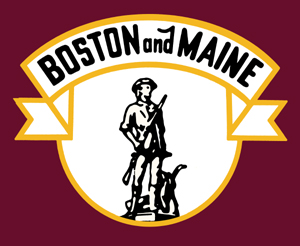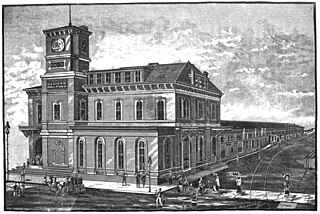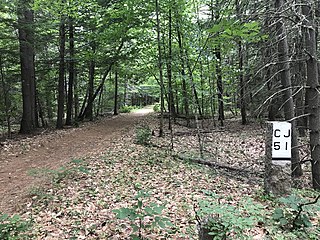
Lake Winnipesaukee is the largest lake in the U.S. state of New Hampshire, located in the Lakes Region at the foothills of the White Mountains. It is approximately 21 miles (34 km) long (northwest-southeast) and from 1 to 9 miles wide (northeast-southwest), covering 69 square miles (179 km2)—71 square miles (184 km2) when Paugus Bay is included—with a maximum depth of 180 feet (55 m). The center area of the lake is called The Broads.

The Boston and Maine Railroad was a U.S. Class I railroad in northern New England. Originally chartered in 1835, it became part of what was the Pan Am Railways network in 1983.

Wolfeboro is a town in Carroll County, New Hampshire, United States. The population was 6,416 at the 2020 census. A resort area situated beside Lake Winnipesaukee, Wolfeboro includes the village of Wolfeboro Falls.

The Boston and Lowell Railroad was a railroad that operated in Massachusetts in the United States. It was one of the first railroads in North America and the first major one in the state. The line later operated as part of the Boston and Maine Railroad's Southern Division.

The Lowell Line is a railroad line of the MBTA Commuter Rail system, running north from Boston to Lowell, Massachusetts. Originally built as the New Hampshire Main Line of the Boston & Lowell Railroad and later operated as part of the Boston & Maine Railroad's Southern Division, the line was one of the first railroads in North America and the first major one in Massachusetts.

The Fitchburg Railroad is a former railroad company, which built a railroad line across northern Massachusetts, United States, leading to and through the Hoosac Tunnel. The Fitchburg was leased to the Boston and Maine Railroad in 1900. The main line from Boston to Fitchburg is now operated as the MBTA Fitchburg Line; Pan Am Railways runs freight service on some other portions.
The Central Massachusetts Railroad was a railroad in Massachusetts. The eastern terminus of the line was at North Cambridge Junction where it split off from the Middlesex Central Branch of the Boston and Lowell Railroad in North Cambridge and through which it had access to North Station in Boston. From there, the route ran 98.77 miles west through the modern-day towns of Belmont, Waltham, Weston, Wayland, Sudbury, Hudson, Bolton, Berlin, Clinton, West Boylston, Holden, Rutland, Oakham, Barre, New Braintree, Hardwick, Ware, Palmer, Belchertown, Amherst, and Hadley to its western terminal junction at N. O. Tower in Northampton with the Connecticut River Railroad.

The Plymouth & Lincoln Railroad is a class III shortline railroad operating on the Concord-Lincoln rail line in central New Hampshire, United States. The railroad consists of two distinct passenger operations, the Hobo Railroad, which offers passenger excursion trains in the White Mountains, and the Winnipesaukee Scenic Railroad, which operates passenger excursion trains along the shore of Lake Winnipesaukee in the Lakes Region of New Hampshire. In addition to passenger operations, the railroad owns the Lincoln Shops, a railroad equipment maintenance and repair facility located in Lincoln, New Hampshire.
The Lexington and West Cambridge Railroad was a railroad company chartered in 1845 and opened in 1846 that operated in eastern Massachusetts. It and its successors provided passenger service until 1977 and freight service until 1980 or early 1981.

The New England Southern Railroad is a Class III shortline railroad that operates out of Canterbury, New Hampshire, and serves industries in central New Hampshire, in the United States.

The Eastern Railroad was a railroad connecting Boston, Massachusetts to Portland, Maine. Throughout its history, it competed with the Boston and Maine Railroad for service between the two cities, until the Boston & Maine put an end to the competition by leasing the Eastern in December 1884. Much of the railroad's main line in Massachusetts is used by the MBTA's Newburyport/Rockport commuter rail line, and some unused parts of its right-of-way have been converted to rail trails.

The Mountain Division is a railroad line that was once owned and operated by the Maine Central Railroad (MEC). It stretches from Portland, Maine on the Atlantic Ocean, through the Western Maine Mountains and White Mountains of New Hampshire, ending at St. Johnsbury, Vermont in the Northeast Kingdom. The line was abandoned in 1983 by MEC's successor, Guilford Transportation Industries (GTI). Guilford retained a stub between Portland and Westbrook. A section in New Hampshire remains in use by heritage railway Conway Scenic Railroad.

The Suncook Valley Railroad was a short-line railroad in the United States, originating in Suncook, New Hampshire, and terminating in Barnstead, New Hampshire. After a long period of operation by lessees, it was operated as an independent railroad from September 28, 1924, until it was abandoned, with the last train operating December 20, 1952. It served the Suncook River valley region in central New Hampshire, stopping in key communities such as Allenstown, Epsom, Pittsfield, and Barnstead.
The Worcester, Nashua and Rochester Railroad was a railroad line that was to link the city of Worcester, Massachusetts, to the city of Portland, Maine, via the New Hampshire cities of Nashua and Rochester, by merging several small shortline railroads together.

The Northern Recreational Rail Trail, also known as the Northern Rail Trail, is a 58-mile (93 km) multi-use rail trail in western New Hampshire, USA, running from Lebanon to Boscawen. It uses the right-of-way of the Boston and Maine Railroad's former Northern Line, which was acquired by the State of New Hampshire in 1996. The trail is managed by the New Hampshire Bureau of Trails.

The Northern Railroad was a U.S. railroad in central New Hampshire. Originally opened from Concord to West Lebanon in 1847, the Northern Railroad become part of the Boston and Maine system by 1890.

The Concord and Claremont Railroad was an American railroad company during the mid-nineteenth century in New Hampshire spanning from Concord to Claremont.

The Portsmouth, Great Falls and Conway Railroad (PGF&C) is a former rail line between Rollinsford and Intervale, New Hampshire, in the United States. At Rollinsford, the line connected to other lines to provide service between the White Mountains and coastal cities such as Boston. At Intervale, it connected to the Mountain Division of the Maine Central Railroad. The rail line takes its name from the city of Portsmouth, near its southern terminus; the city of Somersworth ; and the town of Conway, near its northern terminus. Today, the infrastructure of the former PGF&C is owned by different entities, including the State of New Hampshire, the Conway Scenic Railroad, and the New Hampshire Northcoast Corporation. Some segments are still operated as freight or heritage railways, while other segments are being maintained as rail trails.

The Concord-Lake Sunapee Rail Trail is a 34-mile (55 km), gravel mixed-use rail trail in central New Hampshire that is currently under construction, under control of the Friends of the Concord-Lake Sunapee Rail Trail (FCLSRT). It roughly follows the course of the Concord and Claremont Railroad line, starting in Concord and passing through the towns of Hopkinton, Warner, Sutton, and Bradford, and ending in Newbury at Lake Sunapee. The trail is being designed for use by walkers, cyclists, equestrians, and cross-country skiers.

The Nashua and Lowell Railroad (N&L) was a 14-mile-long (23 km) railroad built to connect Nashua, New Hampshire with the city of Lowell, Massachusetts. Chartered in June 1835, construction began in 1837 and the first train ran the next year. The Nashua and Lowell was the first railroad built in the state of New Hampshire.



















